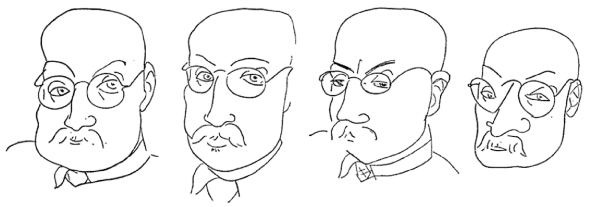
It can be difficult to understand how we are seen by our customers. It can be equally dangerous to think that our mission/vision statements automatically translate into the image which customers have of us. Truthfully, what our customers perceive is much deeper and closer to what we really are than we choose to believe.
The drawings above originated in Henri Matisse’s essay, Exactitude is not Truth (1947). Although these self-portraits are clearly different, we can readily observe that they are all the same man. They share a common quality that is recognizable through the feeling we have when we experience them. Matisse describes it this way: “Everything has an inherent truth, which must be distinguished from its surface appearance,” Matisse writes. The different elements in the four drawings “translate…the organic makeup of the person depicted.”
There is a similar nature that every organization embodies which represents what it is and how it behaves. Call it essence or sensibility or something else. There is a core quality that every organization gives off, which is perceived by its customers.
This essence is what customer-centric businesses develop and deliver to differentiate themselves from product-centered competitors. Businesses may pretend to be one thing or attempt to brand themselves with impressive taglines, but customers will see through these facades if they are not authentic. If the sensibility of an organization is “all about the product,” then overtures to the customer will seem shallow—not genuine. Companies which create a culture that thinks about the customer first will give off a spirit that will instill a new level of life and energy which customers find compelling.
Just as in the Matisse face, there is a wholeness in every organization. This wholeness is produced from individual elements (people, policies, procedures) that can vary tremendously. Christopher Alexander, in The Phenomenon of Life, calls this character, which is “something deeper than features: it is the inner thing which exists over and above the features, and is not dependent on those features. There is a pattern in all of the four pictures of Matisse, which allows the viewer to recognize him. Likewise, in organizations there is a wholeness, which is recognizable by customers, no matter what individual is delivering the product or service that the customer is experiencing. This wholeness is the real nature that determines everything about the organization.
There has been much written about the customer experience, but most of it involves the handling of individual transactions. The REAL customer experience rises out of the wholeness of the organization. When that wholeness is built around a product, it is one-dimensional. When the purpose of the organization is built around the customer, with the product, in effect, being secondary, then it becomes 3D. Matisse calls this the “essential truth” and this is the only truth that matters.
